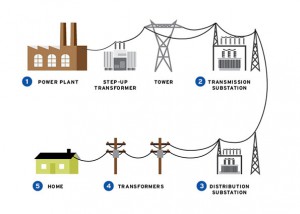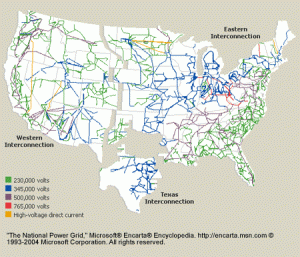What is the energy grid?- The energy grid, or power grid in the United States is the system by which electricity is distributed to consumers across the country. The grid connects the energy producers and the consumers through a complex electrical system composed of three interconnected systems.
What composes the infrastructure of the energy grid?- As stated above the energy grid is composed of three interconnected systems. The systems are divided into the Western Interconnection, the Eastern Interconnection and the Texas Interconnection. According to the US Energy Information Administration, “The interlinked systems now include about 2,000 electric distribution utilities, more than 300,000 miles of transmission and distribution lines, millions of customers, and 7,000 power plants.” The image below is a graphic representation of the energy grid, showing the three interconnections.
How does the energy grid work?- The first step of the grid is the power source, whether that be a from a renewable source such as a hydro-electric plant or a non-renewable source such as a coal plant. Once the power is generated, it is stepped up at a transmission substation in order to be able to travel long distances. In order for the power to be used, it comes off the transmission grid to the distribution grid where it is stepped down at a distribution substation. On the distribution grid it is then stepped down a second time through the transformers so the power is now at the 120 or 240 Volts that we use in our homes and businesses. What are Smart Grids?- Smart grids are a way of modernizing the power grid by adding technology to the current grid such as meters, sensors, and synchrophasors. This incorporation of digital technology enables communication between the grid, consumers, and the operating network providing data on consumption, voltage, damage, and potential problems among others. According to the US Energy Information Administration, “A smarter grid makes the electrical system more reliable and efficient by helping utilities reduce electricity losses and to detect and fix problems more quickly. The smart grid can help consumers conserve energy, especially at times when demand reaches significantly high levels or when an energy demand reduction is needed to support system reliability.”
What are Smart Grids?- Smart grids are a way of modernizing the power grid by adding technology to the current grid such as meters, sensors, and synchrophasors. This incorporation of digital technology enables communication between the grid, consumers, and the operating network providing data on consumption, voltage, damage, and potential problems among others. According to the US Energy Information Administration, “A smarter grid makes the electrical system more reliable and efficient by helping utilities reduce electricity losses and to detect and fix problems more quickly. The smart grid can help consumers conserve energy, especially at times when demand reaches significantly high levels or when an energy demand reduction is needed to support system reliability.”
Pros:
1. Provides power to the country
2. Contributes to the economy in ways such as providing jobs anywhere from at the power plants to the installation of new lines.
Cons:
1. Security threats: “In fiscal year 2014, there were 79 hacking incidents at energy companies that were investigated by the Computer Emergency Readiness Team, a division of the Department of Homeland Security. There were 145 incidents the previous year.” CNN
2. Siting new transmission lines when there is opposition to construction.
3. Reaching renewable energy generation sites can be challenging.
References:
1. US Energy Information Administration: http://www.eia.gov/energy_in_brief/article/power_grid.cfm
2. CNN: http://money.cnn.com/2014/11/18/technology/security/energy-grid-hack/
3. How Stuff Works: http://science.howstuffworks.com/environmental/energy/power4.htm
4. Office of Electricity Delivery & Energy Reliability: http://energy.gov/oe/services/technology-development/smart-grid


Great References and nicely written !
Very nice content and blog, I found it very informative and useful as a postgraduate student. I’m hoping to read more posts such as this one. MBA Dissertation Topics Thanks
I really like the charts and pictures you have included!
Thanks for this article, I realy learned alot and finally understand what I need to know about Dpl only by the help of this article. Would like to know more about Dpl? then visit this link. https://www.techshure.com/
Very nice content and blog, I found it very informative and useful
Konveksi Tas
This is such a useful post. Thank you for sharing this
Pabrik Tas
frastructure of the energy grid?- As stated above the energy grid is composed of three interconnected systems. The systems are divided into the Western Interconnection, the Eastern Interconnection and the Texas Interconnection. According to the US Energy Information Administr Metin2 Pvp Serverler
Thank you for sharing information. It a wonderful post.
Pabrik Konveksi Jogja
The article provides a comprehensive overview of the U.S. energy grid, detailing its infrastructure, functionality, and advancements such as smart grids. It explains how the grid, divided into three major interconnections, distributes electricity from diverse power sources across the country, ensuring reliable energy delivery. The piece highlights the evolution of the grid with smart technologies that enhance efficiency and reliability by integrating digital tools for real-time monitoring and problem-solving. While the grid’s benefits include reliable power supply and economic contributions, it faces challenges like security threats and the complexities of expanding transmission lines. Overall, the article underscores the critical role of the energy grid in modern society and the ongoing efforts to address its vulnerabilities while advancing towards a more efficient and secure system.
https://deshiindustry.com